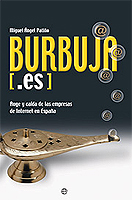“Those who do not know history are condemned to repeat it.” Mindful of these words, Miguel Angel Patiño, editor of the newspaper Expansion, set out to write a book entitled Bubble.com: The Rise and Fall of Internet Enterprises in Spain. With the Spanish case as a backdrop, Patiño examines the excesses that were committed as well as the lessons that were learned. “No economic phenomenon ever created or destroyed, with such speed, so many management personalities and legends the way the Internet did,” the author writes.

Sign up to stay informed about our latest article releases.